Every week, The Mac Weekly interviews one senior majoring in an artistic field at Macalester. This week, we spoke with Camille Erickson, who is double majoring in Art History and International Studies.
Where are you from?
Chicago, Illinois.
How did you choose Macalester?
I was really interested in being in an urban environment. Macalester seemed to place importance on community activism and social change, which were values that were important to me when I was choosing a college. I also knew there was a fairly vibrant art scene. In general, I wanted a liberal arts school.
Has Macalester lived up to your expectations?
I’ve felt very nurtured and supported. I’ve learned a tremendous amount. Sometimes I’m disappointed by the lack of action around social justice issues, there’s more talking than doing. Overall though, it’s a really good place to grow and to question and to be critical. It’s a safe space.
How did you come to be an Art History major?
I loved anything to do with studio art in high school, but I jumped right into the International Studies track once I got here. Sophomore year I had a realization that what I needed to do was Art History after taking courses (Gender, Sexualities, and Feminist Visual Culture and Performance Studies Praxis) with Joanna Inglot. When that happened I realized I loved to look at, talk about, critique and analyze art. I loved the intellectual side around it and the direct interaction with art and artists. The major is incredibly interdisciplinary. I’m one of three seniors this year.
What is the major like?
You take Intro to Art of the West (I and II), Art of the East (Chinese or Japanese), and a couple of studio classes. You then take 200-levels, which range from anything from American Art to Post-Modern Japanese Art. During the fall of senior year you take an Art History Methodology seminar and work on the capstone.
Describe the capstone.
In art history, you write a paper. I also applied for an honors proposal, so that goes into spring term. My paper is about gender and sexuality and contemporary art. Most specifically, it focuses on queer photography in contemporary art, an area that I researched this summer.
How was your summer research project?
It was a student-faculty research collaboration (Keck Foundation grant), and I worked with Joanna. We were looking most specifically at preparing for the capstone. We looked at literature reviews, critical studies, and queer photography. I was trying to find a clear focus. I made connections with artists that I plan to interview. Queer studies is relatively new; there’s not much written about and it needs to be researched. I really enjoy playing a small part in creating that literature, discourse and dialogue. I also want to create visibility for these different artists.
Who are these any particular artists and what do they mean to you?
Catherine Opie, Zanele Muholi, Del LaGrace Volcano—these artists are doing a lot of documentary photography. My underpinning question: how is the queer body represented in visual culture? Additionally, how are these artists creating spaces for queer-identified people to investigate their own multiple identities?
Did you enjoy the studio art aspect of the major?
I took Printmaking I and Ceramics I. I love doing studio art. Printmaking especially has really informed my way of approaching art. It helps me when I’m looking at art. Doing the tangible work reminds me that there’s an artist and process behind the work. It’s not just a final product. It’s also helped me be in contact more with studio art majors. A lot of art historians are not always in direct contact with artists, and I think that’s a shame. I’ve built really close relationships with studio art majors and want to write about their art and make it visible.
What are your plans after graduation?
I’m taking a year off. I hope to do something in the Twin Cities or internationally within an art community, whether that be writing, curating, or working for a non-profit. Then I would like to go to graduate school for art history. From there I don’t know.
Why do you think art and art history are important?
Art is an incredible way for individuals to comment on their own social environments and personal lived experiences. Art drives the world. I really do believe we need more people in the arts. Art has a really positive and provocative community impact. There are many intersections between art, activism and social change. I think art has a special quality in that it can upset established norms, cause us to stop and consider where we’re at. I want to see a society that is more supportive of the arts and more receptive.
Any final comments?
Art history is a huge part of my life. I’ve felt incredibly supported by the department here. I’ve gotten so much personal guidance and have been really encouraged to study what I want to study and go where I want to go. I really love my major.







Grace Davidson • Sep 11, 2019 at 10:00 am
I’m impressed, I have to say. Really rarely do I encounter a weblog that’s both educative and entertaining, and let me tell you, you could have hit the nail on the head. Your thought is excellent; the issue is something that not enough individuals are talking intelligently about. I’m very pleased that I stumbled throughout this in my seek for something referring to this.
Thomas Powell • Sep 10, 2019 at 4:41 am
constantly i used to read smaller posts that as well clear their motive, and that is also happening with this post which I am reading here.
Abigail Tucker • Sep 6, 2019 at 2:13 am
Its like you read my mind! You appear to understand a lot approximately this, like you wrote the ebook in it or something. I believe that you simply could do with some p.c. to power the message home a little bit, however instead of that, this is excellent blog. An excellent read. I will definitely be back.